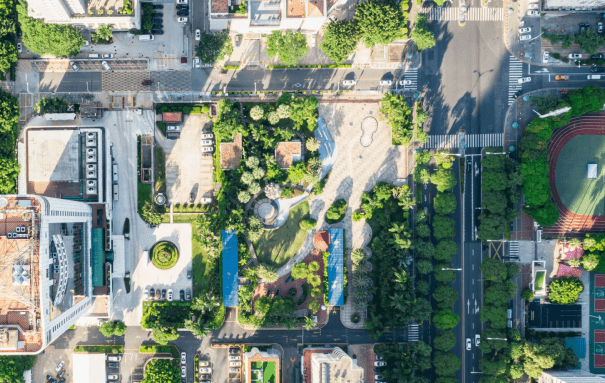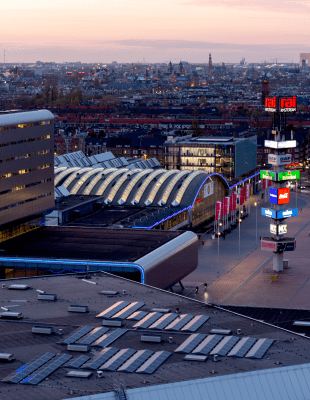The New York City Housing Authority (NYCHA) is the largest public housing authority in North America and provides affordable housing for more than 500,000 New York residents. In this episode of Better Cities by Design, we spoke with Joy Sinderbrand, Senior VP Capital Programs at NYCHA, about the organization's continuous efforts to upgrade homes and adapt their buildings to climate change.
You have not accepted cookies yet
This content blocked. Please accept marketing cookies. You can do this here.
Subscribe on your favourite platform
Native New Yorker, Joy Sinderbrand talks to us about her commitment to the city, the massive scale on which NYCHA operates, and the urgency around retrofitting buildings for not only residential comfort but, critically for climate change. With one out of 15 New Yorkers living in NYCHA housing, the organization plays a crucial role in providing affordable housing for New York’s blue-collar workers, folks who keep the city functioning.
During the COVID-19 pandemic, the importance of so-called essential workers, many of whom are NYCHA residents, came into sharp relief. Our conversation with Joy touches on this topic and how she and her team is working to make housing more equitable in the city. Finally, we also delve into the important topic of sustainability. With more than 177,000 apartments in more than 2400 buildings across New York City, NYCHA has a significant role to play in helping the city on its journey towards net zero and climate resilience.


The Arcadis global podcast
Better Cities by Design
Episode transcript:
We recognize that not everyone is able to listen to our podcast, which is why the show is also available in text. If you would prefer to read what happened in the show instead of listening, please click the link below for the episode transcript.
-
Read full transcript
00:04
Davion Ford
Welcome to Better Cities by Design, a podcast brought to you by Arcadis, where we talk to change makers who are working to make our cities better places for people to live, work and play. I'm your host, Davian Ford, and this is our very first episode, so thank you all for listening in. And what better city to visit first than the world's most famous metropolis, New York City. We are headed there for a conversation with Joy Sinderbrand, Senior Vice President for Capital Programs at the New York City Housing Authority, also called NYCHA, which is the largest public housing authority in North America. In our conversation with Joy, we'll explore the importance of affordable housing for New York residents and how this helps keep New York livable for folks who may not work on Wall Street, but these are the people who really make New York City the capital of the world.
01:01
Davion Ford
New York City, often hailed as the city that never sleeps, stands as one of the most famous and captivating cities on earth. With its towering skyscrapers, bustling streets, and a vibrant mix of cultures, New York City has earned a place in the hearts and imaginations of people around the globe. From the dazzling lights of Times Square to the majestic presence of the Statue of Liberty, the city offers a wealth of world-renowned landmarks and tourist attractions. It's a metropolis that seamlessly blends history, art, fashion, finance, and diverse neighborhoods together, making it an unparalleled destination for millions of visitors each year. For more on this, here is Jee Mee Kim, who not only lives in New York, but is also Arcadis' city executive for the New York City region.
01:50
Jee Mee Kim
New York City can be a challenging place, there's no doubt, but it's still a city that holds a ton of promise and opportunity. It's got an amazing 24-7 energy that few cities have. And really it's a place that accepts everyone. I mean, honestly, that's why there's so many songs written about it.
02:12
Davion Ford
So New York has experienced a remarkable transformation in recent years. The city's landscape has been shaped by shifting demographics and changing circumstances. In particular, the COVID-19 pandemic hit New York hard. More than 3 million people in New York contracted COVID and sadly, more than 45,000 of them died. And those figures are almost certainly lower than the actual numbers. And there have been other changes in New York since the pandemic. Research from the University of Toronto and the University of California Berkeley shows a 26% decrease in mobile device activity within New York's business districts compared to pre-pandemic levels. And it's not just business districts that are suffering from new ways of working. A rise in hybrid work models has also introduced new possibilities for individuals to reconsider where they live, leading to an increased interest in moving out of the city. Despite initial indications that the net migration out of the city would be temporary, as of now, many of the folks who have left the city have not come back. But this has not translated into sharp decreases in the cost of living in New York. According to the website, renthop.com, the average rent for a studio apartment in New York is more than $3,400 a month. And this is far more than your average worker can afford. And the pandemic underscored the vital role of essential workers in keeping the city functioning. The restaurant and grocery store workers, the police and fire officers, people working in cleaning services and utility workers. These are the people who keep New York and every city in the world moving. And for many of these folks, the cost of living remains a pressing concern. The city's soaring housing costs have created a significant disparity between income levels and rental prices making it increasingly difficult for many individuals and families to secure suitable homes. And this is where the New York City Housing Authority, or NYCHA, comes in. NYCHA was created back in 1935 to provide decent, affordable housing to low and moderate income New Yorkers. Once again, here's Arcadis's Jee Mee Kim.
04:25
Jee Mee Kim
During the dark days of the pandemic, New Yorkers relied on our essential workers to keep our city afloat. And these workers and their families really need affordable quality housing. And that's what NYCHA provides. It's a really expensive city to live. And NYCHA is a key reason why New York can have a diverse and thriving population.
04:48
Davion Ford
To learn more about NYCHA and the important work it does, I'm really happy to welcome Joy Sinderbrand to the show. Joy is the senior vice president for Capital Programs at NYCHA, and she's dedicated her career to improving the lives of New Yorkers. With a deep understanding of the challenges and opportunities in providing affordable, livable, and sustainable housing, Joy is at the forefront of shaping the future of public housing in one of the world's most vibrant cities. Joy, welcome to Better Cities by Design.
05:25
Davion Ford
So Joy, we're gonna talk about the amazing work you and your colleagues at the New York City Housing Authority or NYCHA do to provide affordable, livable, and more and more sustainable housing for New York residents. But before we get into that, can you tell our listeners more about yourself and what led you to do the work that you do as to understand that you've essentially got New York City in your DNA?
05:47
Joy Sinderbrand
Well, I am a third generation Brooklynite, and my grandfather was in construction. He helped build the Empire State Building and Ebbets Field. My dad worked on MTA projects. That's a subway, signal systems, and the World Trade Center. And so I'm raising fourth generation Brooklynites, and I care very much about New York City's infrastructure, which for me is transportation, parks, libraries, and housing. So affordable housing is a really critical part of that.
06:19
Davion Ford
Thanks for sharing those details about your family there in New York. As with many things in New York, NYCHA operates on a massive scale. Can you talk a bit about your organization's remit, how many homes you administer, how many New Yorkers you serve, and some of the challenges that you're facing?
06:39
Joy Sinderbrand
Sure! NYCHA is really a city within a city. It's the largest landlord in North America. We house about one in 15 New Yorkers, which is essentially bigger than Sacramento, Atlanta, or Miami. So we're, you know, on sort of scale, we're talking about 178,000 apartments in over 2,200 buildings. And really many of these buildings were built a long time ago, some in the 30s and 40s, many in the 50s to the 80s. So our real challenge is state of good repair. For decades, there hasn't been sufficient funding, either on the capital or the operating side to truly maintain these buildings. And so right now, there's an estimated $40 billion capital need. That's based on a survey we did in 2017. We've actually redone that survey near the end of 2022, and we're finalizing those numbers now to see what's happened over the last five years. We assume and we observe things getting worse. And it's on top of that, that we're addressing the issues of climate change and also recognizing the retrofit needed to do the kind of sustainability work that's necessary to prevent further climate change.
08:02
Davion Ford
New York is known all around the world as one of the most expensive places to live. It's also a place where many, many people want to go to live. And the work that NYCHA does makes that possible for people to live in New York City who don't earn millions and millions of dollars a year working on Wall Street. I guess my question is, can you talk about who the folks are that live in NYCHA residences? And why should those folks who do work on Wall Street also be vested in the work that you guys do?
08:35
Joy Sinderbrand
So NYCHA houses very low and low-income New Yorkers. And when I say New Yorkers, I'm talking about families who have been here for generations and people who've just arrived. NYCHA is where people who really can't afford market-rate housing have their last bastion, the last spaces in those neighborhoods where they can live and they can hold their communities together. And when I say NYCHA residents are really the glue that binds the city together, it's because many of our families are employed in the jobs that really make New York City run. They're bus drivers. They're the cafeteria workers in your kid's school. They're the school crossing guards. They're the home health care aides and retail workers and sanitation workers that really make this city function. And many of them are retirees. So they spend decades doing that critical work, and this is where, on their limited income, it's one of the few places they can stay in New York City.
09:41
Davion Ford
So how do you decide which projects to tackle first? What criteria do you use to determine which investments will do the most to improve quality of life for residents?
09:51
Joy Sinderbrand
I'll start off by saying, again, we are always on a massive scale here in New York, but it's actually grown even bigger for NYCHA. When I started at NYCHA in 2016, the capital projects division was doing about 200 capital projects a year. Now we're doing over 600 active projects and we have about $4 billion of active contracts. So we're investing more and more money, faster and faster. But we haven't caught up with that need that I mentioned at the beginning, that $40 billion plus need to get the buildings to a state of good repair. Most of the money that we get from our city, state, and federal partners is relatively non-discretionary. So I say that because we're working with dollars that have rules. So let's talk first about our priorities. Our priorities are what we call the pillars. It's really stems from an agreement we have with the federal agency, Housing and Urban Development, to focus on heating systems, elevators, waste management, lead and mold removal, mold prevention, pest mitigation. So about 90% of our capital funding is really focused in those areas. Then we often get funding, again, from city, state, or federal that's focused on kind of a defined scope. An example of this is the Sandy Recovery Program, where NYCHA is investing $3 billion in the 200 buildings most severely impacted by Superstorm Sandy. We're also pursuing money after Ida. We get money for particular programs like security or elevators, where we are told which scope item we have to focus on, and then we have to determine which buildings get that investment. And then there's very specific projects. So these are discretionary dollars given to us by local or state officials. And in those cases, we're told which development, what scope of work those dollars are for. So we're very, very careful to make sure they go where they were intended. But I just want to say that when we do have discretion, the type of analysis we do is a combination of qualitative and quantitative. We do that physical needs assessment I mentioned earlier about every five years. And that's really to go in and look at the infrastructure and the structure of buildings and make determinations of where the need is the highest. We layer on that work orders that we've collected from our partners in operations. So every time a resident calls the customer care center, that information is recorded and collated so we can find patterns. So we don't just fix an issue in an apartment when really what the issue is is a systems issue that's affecting the whole line or the whole riser. And then we also talk directly with our partners, our property management staff and operations staff, the boots on the ground, the folks who really know the ins and outs of the developments and to make sure we're not missing any really critical needs that are impacting the health or safety of our residents.
13:08
Davion Ford
In recent years, we've been dealing with a lot of inflation as well as rising construction costs. And I can imagine that's made that more difficult for the work that you guys are doing. How is NYCHA adapting to these challenges and what are you doing to control costs?
13:26
Joy Sinderbrand
We're using every tool in the toolbox. And on the construction side, we're really focused both on what's happening in our shop, so in-house, and then also what we can impact in terms of what's happening with our partners. So to start off with, we've done a process to revamp, essentially, all of our internal processes. And that's with a mindset to not just remove pain points for NYCHA staff, but also to remove pain points for our vendors. And some of what you've probably seen, if you've been working with us over the last few years, is an increase in corporation of technology, project management and, and prevailing wage software to really increase the transparency of our processes, where things are sitting, how long they've been sitting there and the efficiency. So we can really set SLAs for ourselves and make sure that we're delivering back to the vendors and to the residents on time and on budget. We've also been updating all of our specifications, and this is so that they can be more flexible and easier to source, but also so that they're incorporating the resilience and sustainability elements that are going to be so critical for every state of good repair project going forward. And we're increasing our pre-construction investigations. We recognize that a lot of the challenges that our vendors had were getting to a site, starting on a defined scope of work, and then discovering that there's an issue because it is a 60 or 70 or 80 year old building and that complete net scope of work requires additional investment in a state of good repair.
15:07
Davion Ford
I'd like to harken back to something that you actually said earlier when you were mentioning retrofit, actually, because we know that when it comes to decarbonizing cities, it can be relatively straightforward if you're talking about putting up new buildings, right, to put up a highly sustainable building, if you make the right decisions and you want to make that investment. But that that real challenge in terms of carbon in cities is that existing building stock. So how are you and NYCHA directing the money you're spending to really contribute to New York City's carbon and climate goals?
15:42
Joy Sinderbrand
NYCHA is even just passively benefiting New York City. We have 2,400 acres of open space, including a thousand acres of tree canopy. So after the Parks Department, we're really providing the next green investment for New York to absorb some of that carbon. But more practically, in 2021, NYCHA released an updated sustainability agenda. And our goal is to reduce our greenhouse gases by 80% by 2050. And that's going to take action on a lot of different fronts. And so I'll mention a few today, but people should definitely go to our website, Google NYCHA sustainability agenda and see all the activities that are going on. Um, we're not just committed to hosting 30 megawatts of renewable energy by 2026. We've already, we already have eight megawatts installed or in progress right now. We're installing geothermal heating at buildings. We're demonstrating full electrification of buildings. That means putting in heat pumps, induction stoves, point of use water heaters. We're developing a cold climate heat pump. And I want to kind of bracket all of the sustainability work with its sister work in the resilience department. So this is the idea that we have buildings that are already being impacted by climate change. And due to the vulnerability of the structures and due to the vulnerability of our residents who are young, very young, very old, have comorbidities, and certainly have economic challenges, we know that there is a time sensitivity to retrofitting our buildings. We've invested $2.8 billion to date in over 200 buildings, which are now being protected for storm surge and also with full backup power generators so that as disasters hit New York, NYCHA residents are particularly protected against some of those impacts.
17:50
Davion Ford
When we think about sustainability and the impact that NYCHA can have, you're talking about the billions that your organization is investing on an annual basis, supply chain comes to mind because obviously with buying power, you have the ability to leverage that, to support and advance broader social and economic movements. such as promoting, you know, workforce development and supporting local businesses. Could you talk a bit about that aspect of your purchasing power?
18:22
Joy Sinderbrand
I'll go back to an example I just mentioned in terms of the cold climate window heat pump. So NYCHA is going to need over 150,000 cold climate window heat pumps over the next five to ten years if we're going to be able to electrify parts of our portfolio to align with that greenhouse gas reduction, which in our case is connected to a local law, local law 97. And this is something that the industry actually hadn't developed yet. So we worked with state agencies, the New York Power Authority and NYSERDA, to run an industry competition and essentially develop and produce 30,000 of these units. And so the state agencies are supporting us in both running that competition and funding those initial 30,000 unit purchases that we can put in NYCHA buildings without having to relocate residents. So really the idea is that you can just slide these into place and the residents will benefit without having to move to new apartments. Beyond NYCHA, once this is developed and in production, it's going to be applicable to many, many buildings in New York City, in the Northeast, and that includes other public and affordable housing operators, but it also includes private property owners, cooperatives, you know, and buildings that can benefit from this type of retrofit material.
20:01
Davion Ford
My next question actually is really about the residents there. What is NYCHA doing to really engage with them and to include them in the development and construction of their homes and ultimately their communities?
20:14
Joy Sinderbrand
That's a really good question. Residents are at the forefront of everything that NYCHA does. And while we're spending and investing extraordinary amounts of money, the resident voice really has to be forefront. I will talk about a couple of different examples and also recognize that there's always room for improvement here. Resident voices have always been included in our planning and development stages for capital projects. And depending on the project, we are able to incorporate either a lot of input on say a grounds or playgrounds project and some input on what are really structure or infrastructure projects which are effectively defined by code. But the capital projects stakeholder procedure has been updated and we're actually rolling out a much more expanded set of touch points so that resident leaders and property management staff are much more involved with the design development of the projects and are much clearer on the timeline throughout the project. And so that's something that NYCHA residents will be seeing very soon. There are also other initiatives on the real estate front that include hiring design builders to come in and do a comprehensive modernization of developments. And in that case, we're actually putting resident leadership on the RFP committee to sit with NYCHA staff and select the design builders who will be working at their development. And the real estate department has been working on on a public-private partnership model for several years now. They also have residents on their RFP committees to choose the developers or nonprofits that are doing the investments, the capital investments, and the maintenance in their development. So this is something that we're doing across the board. We have NYCHA residents on the NYCHA board. And we have NYCHA resident councils that we that we collaborate with and confer with on almost every major initiative.
22:39
Davion Ford
Joy, thank you so much for your time. And let me thank you and all of the folks there at NYCHA for the great work that you're doing to help keep New York City affordable and livable for people there. Thanks so much.
22:53
Joy Sinderbrand
Thank you.
22:54
Davion Ford
That's it for our first episode of the show. A big thank you to all of you listening out there and also to Joy Sinderbrand for being our first guest. Please stay tuned for future episodes as we continue to bring change makers to the table who are driving progress in urban development. And please, please be sure to subscribe and check out our future episodes. I'm Davion Ford and you've been listening to Better Cities by Design, a podcast brought to you by Arcadis, the world's leading company delivering sustainable design, engineering, and consultancy solutions for natural and built assets. You can learn more by visiting our website, arcadis.com, or by following Arcadis on LinkedIn or Facebook. And please stay curious, get inspired, and remember the future belongs to those who dare to make a difference in the cities we call home.




